Content Strategy and Crisis Communication: Your Content During the COVID–19 Pandemic and Beyond
April 13, 2020
Crisis is scary.
Crisis is scary, but not just because the crisis itself is scary. While the actual crisis contributes considerably to our fear, it also exasperates the systems we have in place to protect us from fear. Things like trust in existing processes, and clear lines of communication.
Crisis requires clear communication, but the crisis itself makes communication as difficult as possible.
Some of this is logistical. Information begins to overlap and overwhelm, and the space usually given to context and confirmation is removed. Things move too fast to keep straight.
Even more of it is psychological: the stress of the crisis itself scrambles our brains. Figuring out what to say is already hard. Added psychological weight makes it even harder.
Which means when it comes to developing messaging, we tend to throw our carefully tended content strategy plans out the window. These are not things that fit nicely into an editorial calendar, but instead require fast thinking, deep consideration, and a lot of grace.
We’re seeing that now in 2020 during this pandemic, but this is not a situation unique to pandemics: communication and content strategy during crisis is an ongoing concern. We might plan for it, but we’re usually fortunate enough to never have to implement it. And, even if we do plan for it, the unpredictability and stress around the crisis itself makes those plans feel less than sufficient.
In this post, we’ll talk through the different levels of thinking needed to effectively communicate (and, sometimes, not communicate) to your audiences during a crisis. We’ll talk about:
- Understanding Your Starting Point
- Understanding Your Audiences
- Creating a Response
- Being Honest and Clear
- Content Format: How Your Message is Built
Understand Your Starting Point
First off, understand that regardless of how prepared you are to communicate during a crisis, you’re never really prepared. And that’s perfectly fine.
Most organizations — especially small and resource-strapped organizations — do not have the resources or infrastructure to both plan and keep up-to-date a formal crisis communication plan. Which means while it’s easy to say something flippant like “You should have a crisis communication plan in place and practiced,” in reality — among rapid changes, a lack of information, and constant adjustments and uncertainty — even the best-laid communication plan is going to fall apart.
This is normal. Crisis doesn’t wait for you to have your paperwork in place before wreaking havoc.
If you’re reading this post, there’s a good chance a crisis is already underway. (In fact, if you’re reading this post around the time it’s published, the COVID–19 crisis is very much underway and has been for months.) You don’t have time to go back and plan, so the best you can do is take a deep breath and start right now.
Or maybe you’ve already started and you’re worried you already messed it up. Chances are, you have not messed it up.
If you’ve already rushed less-than-perfect messaging or site functionality — the kind of thing where you say “it’s not great, but we got the message out” — you’re in luck: you’ve already gone through one iteration of messaging, and if the crisis is widespread enough, you’ve also done it alongside thousands of other organizations.
Remember, your small part of the web can be changed, which means if you need to adjust your message, you can.
That was a pep talk. Now let’s talk about the “who” of this communication plan.
Understand Your Audiences
Let’s take a second to discuss the difference between self-inflicted crisis and external crisis.
A self-inflicted crisis is most often a crisis of poor decision making. It might be a crucial business mistake (such as promising more than your infrastructure can keep up with), or it might be a public relations mistake (such as the fallout from an inflammatory tweet, or an insensitive advertising campaign).
This is not the level of crisis we’re talking about in this post.
We’re talking about a crisis instigated beyond your walls and control that will potentially affect your customers or your organization. These are disasters that affect more than just business dealings, but also community health and safety. Tornadoes, for example. Or more timely: a pandemic.
The classification between self-inflicted and external is worth bringing up because, during a time of crisis, the distinction tends to fall away. Regardless of the crisis we find ourselves in, we often find ourselves frantically trying to address the issue and provide some level of useful communication.
When in the middle of a crisis, all we know is that the crisis is threatening, which means there’s a part of us that begins addressing the crisis from an angle of self-preservation. We message for ourselves, rather than for our audiences.
Which is why it’s important, before any message goes out, to take a deep breath and consider who this is meant for, and what they expect out of us.
When it’s time to craft a message, ask yourself the following:
- Who is most likely to read this message?
- How might this crisis affect the products or work our audiences expect?
- What do they need to know about those products or work that is specifically tied to this crisis?
- What situations might our audiences find themselves in, and how do we delicately send a message with that in mind?
- Does this need to be said now? Can this wait until things slow down?
Taking time to think about these things — even if it doesn’t change your planned messaging — allows you to mentally shift your thinking beyond self-preservation (and, trust us, even if you don’t mean to, part of your mind is thinking about self-preservation) and toward providing usable information.
Finally, don’t forget that your audiences contain multitudes. Remember that not every message needs to be blasted to every single email address you’ve collected over the past ten years. So let’s add one more thing to that list:
- Is there a pressing need to inform every person you’ve ever talked to? Or can this be communicated to only those who need to know?
How you communicate depends deeply on knowing who is affected.
Create a Useful Response
In my email, I have a BACN folder.
It was created on Cyber Monday a few years back, and it helps collect marketing emails from all of the businesses that I’ve interacted with. It’s not quite SPAM, because I often keep tabs on these organizations from time to time — I don’t want to completely miss those messages — but it does help separate out a bulk of them from my day-to-day correspondence.
Every Cyber Monday, without fail, it fills up with emails from companies I hadn’t heard of since … well, last Cyber Monday.
This year, I didn’t have to wait until Cyber Monday.
The problem during this current pandemic crisis is that it feels like everyone I’ve ever interacted with has sent me an email detailing their response to COVID–19, regardless of how relevant it is to my dealings with that organization.
Much like an overflow of marketing content on Cyber Monday, I’m receiving an overflow of crisis communication for situations in which I am not in a crisis, much of it tied to organizations who don’t really know what to say, but feel they have to say something.
Messaging around a crisis should scratch a psychological itch. While there are many things to be scared about in terms of a pandemic, one of the biggest and most unsettling is a fear of the unknown. As an organization, you can help ease that fear by focusing on things that need to be known. Otherwise, your email is providing more agitation, because it is not a singular message on its own: instead, it’s another in a long flood of emails about whatever horrible thing just happened (or is happening).
Determining the Target Message
Your overall message should be useful. Above everything, look at what you’re planning to say and ask yourself “Is. This. Useful?”
It’s worth noting that useful doesn’t need to be exhaustive, nor does it need to be technical. Your goal with communication during a crisis is to provide a bit of direction for people who have a question about the services or products you provide.
You don’t need to solve every problem, but you do need to think of those who might have immediate issues and confront those, while simultaneously addressing unknowns as a work in progress. What people are looking for is confirmation.
- What will happen to my tickets for a show that has been canceled? Will (or can) I get a refund?
- How can I pick up my student’s belongings now that school has been canceled for the year?
- How long will it take for you to answer my phone call if I have Internet issues?
- What will happen to my appointment for an elective medical procedure?
Really, your messaging will fall into one of two groups: those that address active needs, such as whether or not an event has been rescheduled, and those that address passive needs, such as how your organization has been compromised for future interactions. Some examples:
- Good: “Rage Against the Machine has rescheduled their tour. Your ticket can be used for the rescheduled date. Once the date is set, we will work with individuals if they need a ticket refund.”
- Good: “Due to the governor’s occupancy limit, our lobby will not be open for the foreseeable future. Please make an appointment to meet face-to-face, or use our online banking app.”
- Bad and Not Relevant: “We are working as hard as we can to continue providing you the level of service you expect during these trying times.”
The first two messages are clear and useful. They provide information about a business or service, and answer relevant questions before they’re asked.
The last one is just … talking. It’s a message of “hey, we too are affected!” without providing any useful information. Don’t do that.
Additionally, the timeliness of your messaging should be considered. We all want to immediately show our reaction, to show how we’re affected, to manage self-preservation through communication. But unless you are providing some kind of immediate service, your message risks getting lost in that pile of crisis responses.
Targeting Your Response
Finally, remember that not everyone will need the same message. Not everyone on the mailing list needs an update to your store hours if a majority of them order online from multiple states away, and not everyone needs yet another airline email talking about how they’re doing their best if they don’t currently have a flight booked.
To tackle this, clearly spell out the things that will be affected by a crisis. These might include:
- Business closures or adjustment of store hours
- Service interruptions
- Movement or adjustment to scheduled events or meetings
Then, think through who needs to hear that message. (Often, this means being able to effectively segment your audiences, which might be beyond your current data structure, so do the best you can with the information you have.)
- Do they currently have a ticket or reservation? If so, respond to just those people about cancellations and schedule changes.
- Is their neighborhood going through a service upgrade? Inform that neighborhood.
- Does this relate only to users who have a specific kind of account? Consider relaying that message within their individual account summary screen.
The logistics of this will be complex and messy, especially if your organization does not have cleanly sorted audience groups or any data telling customers apart from each other, but considering the relevancy of your message to unaffected groups can allow you to write an email or message that takes them into account.
This Is Not An Opportunity
Finally, understand that a crisis is not an opportunity, and that self-preservation is very easy to sniff out.
There’s a fine line between talking about how your service can help during a crisis and blatantly exploiting the crisis for your gain, and it often falls upon two things:
- Your ability to write and promote in a way that’s both aware of and supportive of your audiences’ potential situation.
- Your ability to write in a way that is real and honest.
Neither one is easy, but both can be done — with help. If you are communicating something beyond support content during a crisis, please please please have someone else read it, especially, if possible, someone who is currently experiencing the lower points of the current crisis.
It’s not a bad thing (as we’ll mention a bit later) to write a blog post about how your service can be used during a crisis, especially if it’s done in a way that’s helpful to existing customers. It’s maybe more sketchy to begin touting your VR solution as “the ultimate quarantine party pack” or making cracks about the sudden influx of downtime.
With every piece of information you put out there, ask how it will look to someone who has recently lost a job, who knows someone at risk, or knows someone working in health care or in a grocery store. Also, please understand there are plenty of people who are not working at home — they’re still working within an active population to provide basic services.
Be Honest and Clear
Being honest and clear in your messaging is more than just putting your audiences at ease; in fact, at ease may not even be the message you’re going for. But, because as humans we often want to make people feel better about our organization, we often over-soften our messaging, or steep it in euphemism. Which means we begin falling into some traps.
Let’s talk quickly about a few things we should provide when crafting crisis communication.
Stay Away From Euphemisms
“Unprecedented”
“Now, more than ever”
“There’s no better time to…”
“We’re all in this together”Any more?
Avoid hugely overused phrases in what you write, they become meaningless very quickly.
Say what you mean, in a fresh way.#Content #ContentDesign #Comms #CoronaComms
— Lizzie Bruce, content design and strategy 🏠 (@CakeContent) April 8, 2020
Once you’ve written your content, please look through it again and remove the euphemisms. We’ve heard “In these trying times” and “During these times of uncertainty” so much over the past few weeks that they’ve become not only cliche, but actively insulting.
During any crisis, cliche language begins to become a caricature of itself, quickly losing both meaning and authority, leading readers to feel disenfranchised, as if your message was hastily thrown together and then ignored.
Sometimes you cannot help this if messaging is posted early on, but again remember we’re talking about the internet here: you can review your crisis messaging a week later and adjust it to make it more real and more genuine.
Plain Language
Additionally, any crisis worth its weight is going to be accompanied by medical, financial, and societal consequences, which means the agencies and organizations tied to helping navigate those consequences are going to start throwing a lot of very big and unfamiliar words at you.
During the current pandemic, some of us have learned about social distancing, and some learned about the virus’ incubation period, and some have learned the difference between different tests, but that doesn’t mean everyone has learned those things.
Given the potentially wide range of different cognitive and societal context you may find in your user base, the assumption of any knowledge can be dangerous and reckless. Instead, make sure you read through your messaging in a way that identifies potentially troublesome language, or have someone who depends on plain language to read it themselves.
Lizzie Bruce is providing a free-to-use COVID–19 clear language list, but in reality many of these terms are simply crisis words. Additionally, Content Design London, an account run by the brilliantly clear Sarah Richards, is a go-to for discussion around both this current crisis and any ongoing issues around writing for crisis and inclusiveness.
For more resources on plain language:
- Readability Guidelines: Clear Language > Legal, medical and financial terms
- Plain Language dot gov
- XKCD’s Simple Writer
- A previous post here on Eating Elephant on plain language and readability, as part of a series on editorial accessibility.
Simple Truth
Of course, being clear isn’t just about writing in simple language: it also means being honest and forthcoming with the consequences of the current crisis.
If we don’t know what is going to happen, we can simply ease fears by saying that clearly and with as little euphemism as possible. An example is listed above regarding Rage Against the Machine concert tickets:
- Good: “Rage Against the Machine has rescheduled their tour. Your ticket can be used for the rescheduled date. Once the date is set, we will work with individuals if they need a ticket refund.”
This communicates that:
- You are aware that some people will need a refund
- You are planning for refunds to be allowed
- But you cannot take on that process until the new date has been set
The message is clear, straightforward, and truthful even in its unknowns. This is relevant: we all simply want the truth. The largest political issue that’s arisen during this current pandemic is tied to simply being honest about the situation. People in crisis need to know two things:
- What’s known
- What’s not known
That last point is key. If you’re a grocery store, you want people to know that you provide curbside pickup, and that your hours have changed due to shifts in staffing. However, you might also want them to see a list of items that are in high demand, or you may want to communicate that you simply do not have a timetable on when business will return to normal.
There’s really only one thing you need to communicate during crisis: the truth, and how much of it you know.
Use the Format that Best Fits Your Message
What we’re talking about through all of this is, essentially, strategic content planning, which means it’s more than just what you say. It’s also how you say it. Form follows function, as they say. The level of seriousness in your communication — as well as the frequency or length — will deeply affect the templates you’ll need to effectively display and broadcast your message.
Some things to think about:
- Are you planning a one-time message? Or will this be a series of ongoing updates?
- Is your communication plan tied to providing crucial information on your product or service, such as closings or availability, or is it more focused on use and maintenance during the crisis?
- Are you interested in providing helpful advice during this crisis? Will that advice feel helpful, or will it feel particularly tone-deaf?
Let’s talk through the formats some of this crisis communication might take on your website.
The Alert Banner
More than anything (not counting A Special Message From Our Company™ emails), the current COVID–19 pandemic has led to an always updated parade of alert banners.
Alert banners should be simple, alerting the site visitor to something.
- Good: We will be closed until further notice. Learn more about how the tornado may affect your membership.
- Not Great: Read more about our COVID–19 response.
The first one is a clear headline that helps me understand exactly what is happening and leads me to further information. The second is unclear and, to be honest, gets lost in the fact that everyone is saying the same thing. As a site visitor, we have no clear reason to click on that.
 (An example of a clear alert message from the Children’s Museum of South Dakota.)
(An example of a clear alert message from the Children’s Museum of South Dakota.)
Finally, make sure your alert messages are short and to the point. A paragraph-long blurb about what you’re doing and several links to other resources is a bad use of your alert, difficult to read (given the nature of alert design) and impossible to manage on a mobile device. Write one or two quick lines and send them to the longer page.
The Home Page Section
If your site doesn’t have an alert banner, it instead might use an area on the home page to deliver a message. While properly designed alert banners are created to quickly focus attention on a specific topic site-wide, home page sections tend to blend in with the scope of content already present on the home page, so they require a bit more than just a single sentence.
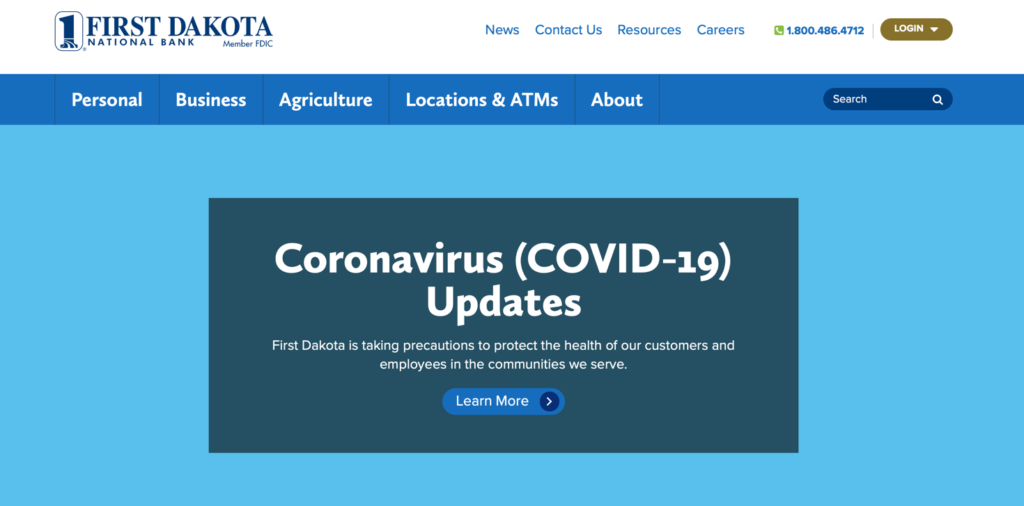 (An example of repurposing a home page hero image as a COVID response from First Dakota National Bank.)
(An example of repurposing a home page hero image as a COVID response from First Dakota National Bank.)
If home page content is where you’re going, understand that it needs to be as clear and concise as the alert banner, but it will allow you a bit more space in terms of furthering the message.
The Dedicated Page
For longer and more detailed information on a specific crisis-related topic, it’s time for a dedicated page. While your alert banners and home page sections might be headlines or summaries, the dedicated page is going to list the full scope of your crisis messaging. Depending on the level of information you need to push out, it may even be multiple pages.
Looking back at the Children’s Museum of South Dakota, the site-wide alert banner led to a full-page detailing what people will actually need to know about the museum during the COVID–19 pandemic.
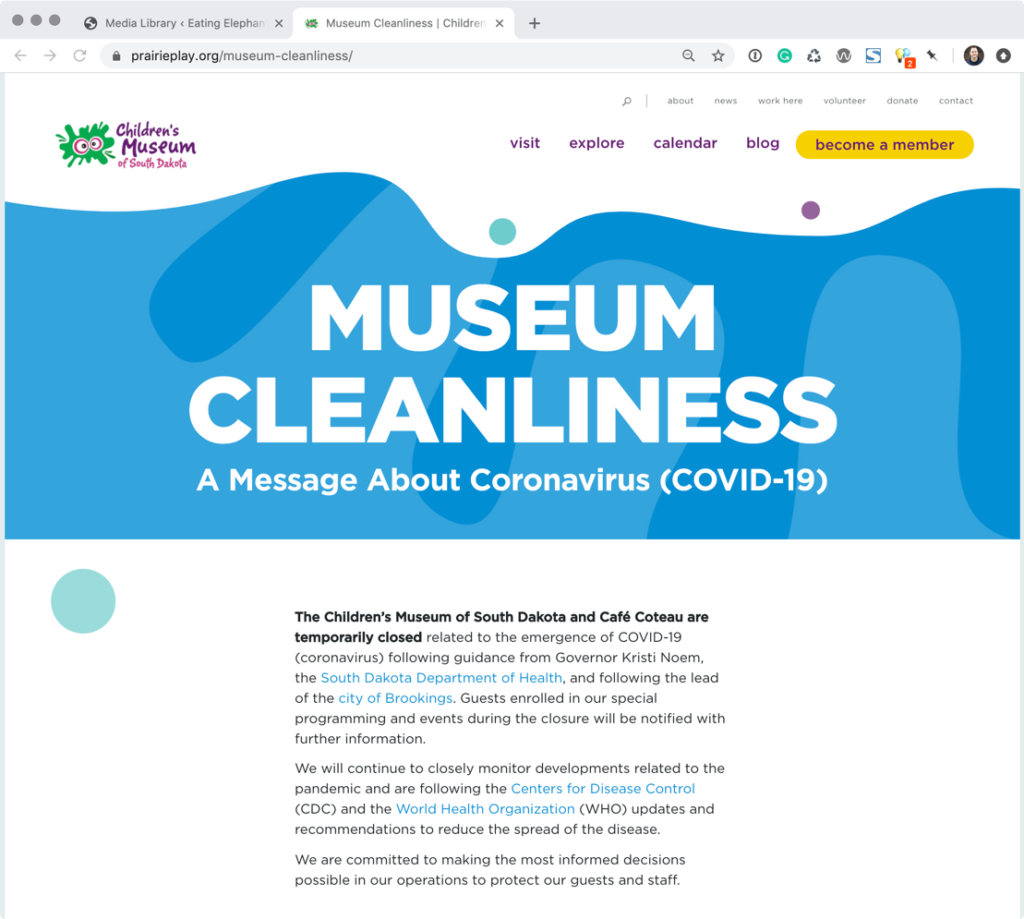 (The Children’s Museum of South Dakota’s full-page detail on museum cleanliness.)
(The Children’s Museum of South Dakota’s full-page detail on museum cleanliness.)
Meanwhile, Confab — an annual content strategy conference — provided several pages of content related to their response to the pandemic and how it will affect the conference, ticket prices, and attendance.
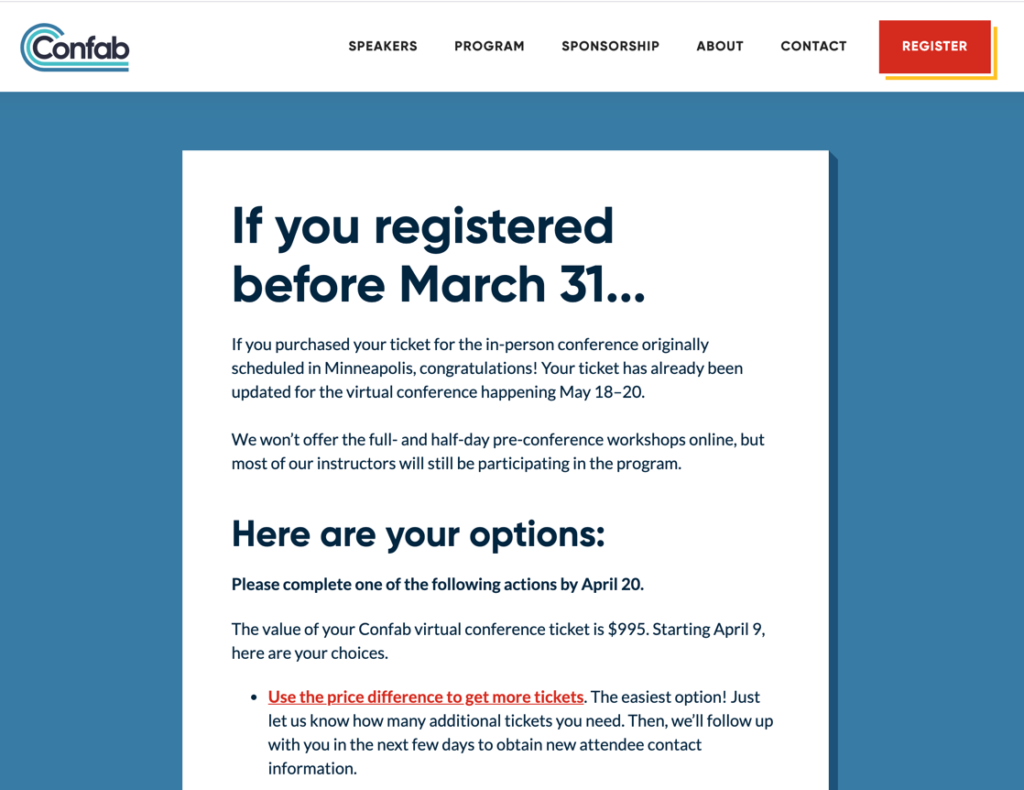 (One of Confab’s targeted detailed pages.)
(One of Confab’s targeted detailed pages.)
The News Category
If you are providing ongoing updates throughout the scope of a larger crisis — especially relevant to industries and government agencies directly connected to ongoing support — a single page simply isn’t going to do it. In this case, you need a news feed, which will allow you to continuously push updates to a single location, providing up-to-date information whenever it comes.
For example, the University of North Dakota has provided an ongoing news feed that serves as a one-stop shop for all COVID–19 content.
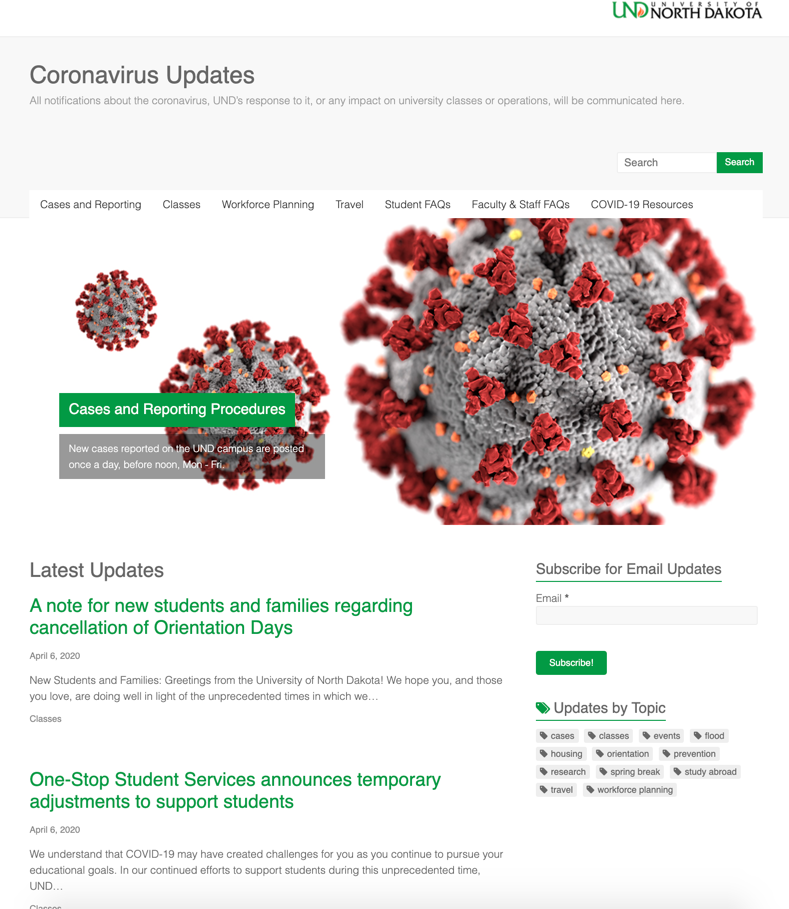 (University of North Dakota’s pandemic news feed was created using existing blog content types.)
(University of North Dakota’s pandemic news feed was created using existing blog content types.)
Depending on how your site is set up, this might simply be created through a category news feed, or maybe you’ll need to do a bit more work in creating someplace where crisis-specific articles can be posted. Regardless, you should make sure:
- The feed itself is well labeled, with the purpose clearly set
- All articles include a date
- Editors curate outdated information with some kind of depreciation text, such as “This information is outdated, please view [this page] for up to date content”
The Blog Post
Finally, we know that not all content is going to be directed at the crisis itself. We know that because … well, this post itself is not directed at the current crisis, and instead is a way for Blend and me to post what we feel is helpful and relevant information tied to our industry or product.
Blog posts about what you can do during a crisis are okay, as long as they’re written in a way that takes the gravity of the situation into account. Blog posts somehow tied to the crisis should provide information or clarification. Remember: people will see through posts that feel sales-y or are tied to self-preservation.
For example, Intercom — a company that provides tools for real-time communication with on-site customers — has provided a great post on how to better use their service during the current pandemic. What’s notable is that it’s not directly selling the service, and instead providing guidance to those who already use their service.
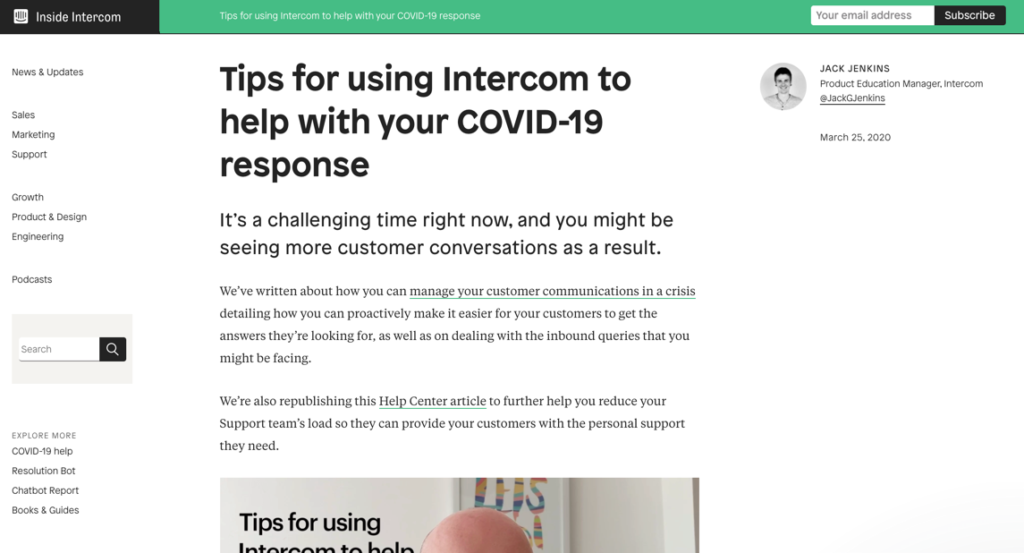 (Intercom’s post on how to use their service during a pandemic helps provide value to their customers while still addressing the overall crisis.)
(Intercom’s post on how to use their service during a pandemic helps provide value to their customers while still addressing the overall crisis.)
Not all blog posts are as relevant, however.
Less useful are blog posts that feel like they are attempting to capitalize on the situation, especially if the topic lands outside of your organization’s usual jurisdiction. We caught a lot of articles about how to work from home as a significant number of “remote-able” businesses turned to work-at-home practices, and after a while they became … well, they just became a lot. Not necessarily due to the topic itself, but due to the overwhelming number of organizations that posted their take on “working from home” at once.
Listen, we know there are no new ideas in the world. But take care to make sure your message hasn’t been beaten to death before you write it. Provide value, even if it’s just a unique spin on a new idea, so that your blog post looks more like usable content and less like piling onto an opportunity.
Your Mileage May Vary
Goodness. This is all exhausting.
So keep in mind a few things as you move forward with whatever crisis you’re currently in: take a deep breath, gather your thoughts, and focus on the message that needs to get out there.
In times of crisis, you’ll find that there are few people who handle it in a similar way. Your organization may be the only one in the community facing the consequences of a crisis in a specific way. You may not have the staff that other comparable organizations have. You may simply not know what to do because you don’t have all of the information yet.
As with anything, your mileage may vary. But no matter what, there are some constants.
Be honest, be truthful, and provide as much information as you need to provide without overwhelming your users.
Understand that you are not alone — yes, I’m going to say it … you and many others are all in this together — despite your situation. Even with that said, remember that some are in this much deeper than others.
Context, honesty, and clarity are necessary to provide as much information as you can without overwhelming and discounting the people who visit your site.
More than anything, give yourself a little grace. Allow a mistake or two, and strive to continue communicating as well as you can.
Good luck.

